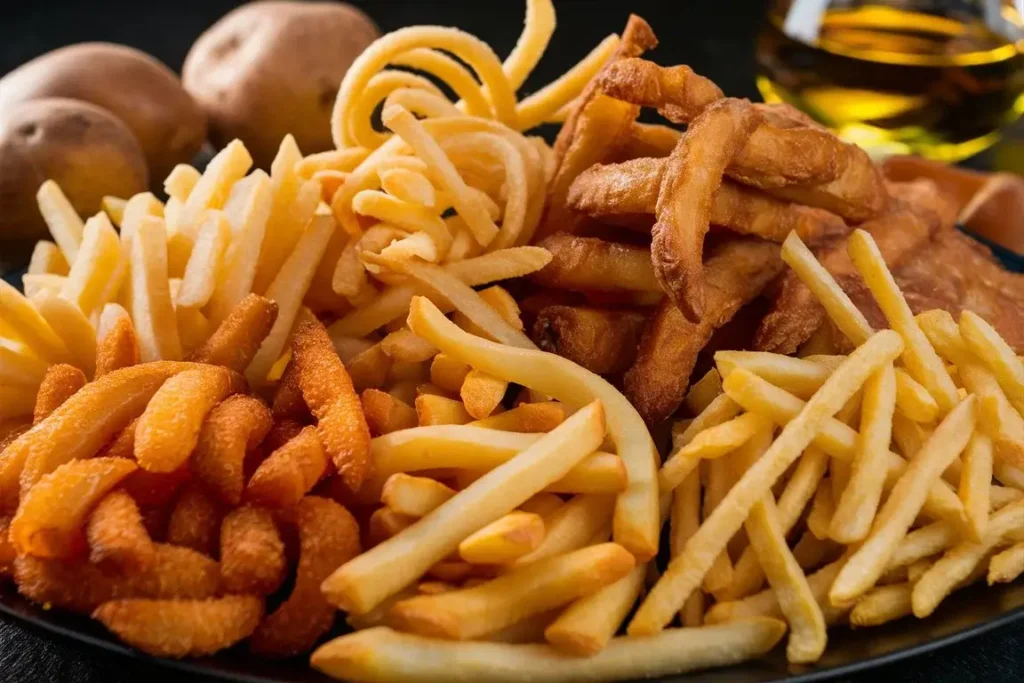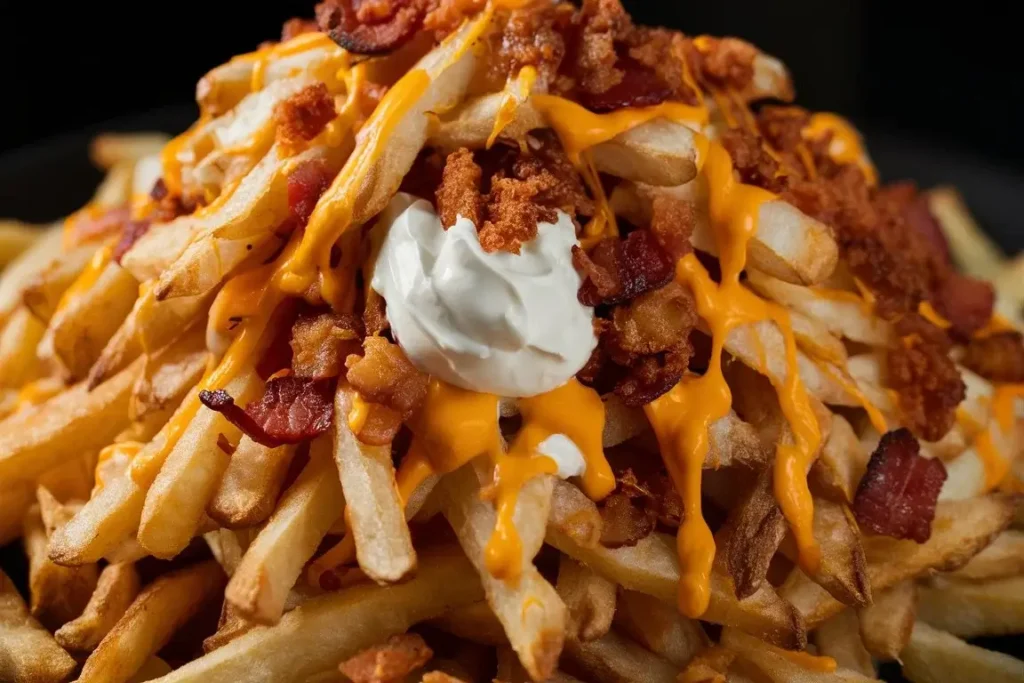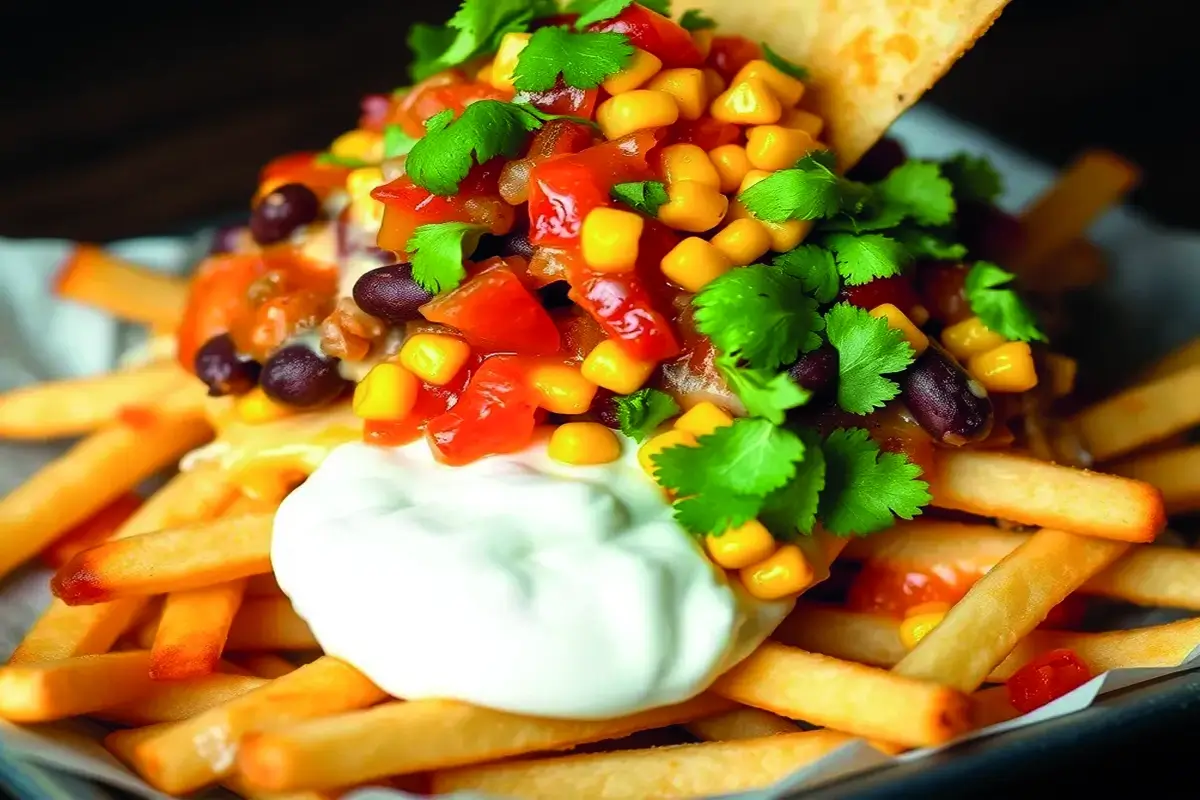Table of Contents
French fries are more than just a snack—they represent comfort, nostalgia, and a universally loved indulgence. Whether you’re at a fast-food joint, a gourmet restaurant, or enjoying a meal at home, French fries are likely to be part of the experience. But what does French fries mean, and why have they become such an integral part of our culinary culture? In this article, we’ll explore the history, significance, and types of French fries. We’ll also delve into frequently asked questions, so you leave with a deeper understanding of these crispy delights.
The Origin and Meaning of French Fries
What does French fries mean? French fries, also known simply as “fries,” are thinly sliced pieces of potatoes that are fried until golden and crispy. The term “French” in What does French fries mean? refers to the cooking method of “frenching,” which means to cut into thin strips. This culinary term also hints at a French influence—though there’s ongoing debate about whether French fries actually originated in Belgium or France.
The history of What does French fries mean? is a topic full of contention and myths. Some sources attribute their origin to Belgium, where villagers supposedly fried fish and potatoes in the winter. However, French culinary traditions also take credit, making it difficult to pinpoint one specific origin. Smithsonian Magazine provides an in-depth exploration of this culinary history, adding a layer of mystery to these crispy, golden treats.
In modern times, What does French fries mean? has become a globally recognized comfort food. Whether they’re served as a side dish with burgers or topped with gourmet ingredients, their appeal is universal. French fries are popular in North America, Europe, Asia, and beyond. Their simple yet indulgent preparation—deep-frying—offers both texture and flavor, which are essential elements in comfort food. To learn more about how What does French fries mean? fit into American culinary culture, you can explore Serious Eats for insights into their evolution.
Key Points About French Fries
- French fries are thinly sliced and deep-fried potatoes.
- The term French in French fries refers to the technique of slicing thinly, known as “frenching.”
- There is a debate between Belgium and France about the origin of French fries.
Different Types of French Fries

The meaning of French fries isn’t limited to their standard form. French fries come in many shapes, sizes, and styles, each with its own unique texture and flavor profile. Let’s explore some of the most popular varieties:
1. Classic French Fries
The classic cut is a straight, thin fry, fried to perfection. These are typically salted and served as a side to burgers or sandwiches. They are the standard in fast-food chains and are universally recognized.
2. Curly Fries
Curly fries have a distinctive spiral shape, achieved using a spiral slicer. They are often seasoned with a blend of spices, which gives them a unique flavor.
3. Shoestring Fries
Shoestring fries are extremely thin, almost like crispy potato sticks. Their texture is crispier compared to other varieties due to their thinness.
4. Waffle Fries
Waffle fries are cut with a lattice pattern that provides extra surface area for crispiness. They are perfect for holding dips and are often served in fast-casual dining settings.
5. Crinkle-Cut Fries
Crinkle-cut fries have a wavy shape that adds texture. This type of fry is loved for its balance between crispiness on the outside and a soft interior.
6. Steak Fries
Steak fries are thick-cut fries with a soft interior. They are more substantial, providing a greater potato-to-crisp ratio. This makes them a favorite for those who love the taste of potato.
7. Loaded Fries
Loaded fries are French fries that are topped with various ingredients like cheese, bacon, sour cream, or chili. They are often referred to as “dirty fries” due to their messy yet indulgent nature.
Types of French Fries At a Glance:
- Classic: Thin and crispy
- Curly: Spiral and seasoned
- Shoestring: Thin and extra crispy
- Waffle: Lattice-cut for dipping
- Crinkle-Cut: Wavy texture for extra crispiness
- Steak Fries: Thick-cut, soft inside
- Loaded Fries: Topped with delicious extras
The Meaning of Loaded Fries

What does loaded fries mean? Loaded fries take French fries to the next level by adding a variety of toppings. Typically, these toppings include shredded cheese, crumbled bacon, green onions, and sour cream. The meaning behind loaded fries is simple: to transform regular fries into a decadent, meal-like experience.
Loaded fries, also called “dirty fries” or “fully loaded fries,” are designed to be shared and enjoyed as a main dish or appetizer. They combine the crunch of fries with the creaminess of cheese and the smokiness of bacon, creating a satisfying contrast in flavors and textures.
Popular Loaded Fries Variations
- Chili Cheese Fries: Fries topped with chili con carne and melted cheese.
- Poutine: A Canadian classic made with cheese curds and gravy.
- Buffalo Chicken Fries: Fries topped with buffalo chicken, ranch dressing, and scallions.
Loaded fries are a great way to add versatility to the humble French fry and make them the star of the dish.
What Are French Fries Made Of?
The base ingredient of French fries is, of course, potatoes. But the type of potato and preparation method significantly impact the outcome. Typically, starchy potatoes like Russet are used because they have a higher starch content and less moisture, which makes them perfect for frying. Here are the main ingredients that go into making French fries:
- Potatoes: Russet potatoes are preferred for their starchy texture.
- Oil: Vegetable oil, such as canola or sunflower, is commonly used for frying.
- Seasoning: Salt is the classic seasoning, though other spices and herbs can be added for extra flavor.
For making loaded fries, additional ingredients like cheese, bacon, or chili are added after the frying process. Properly prepared fries should be crispy on the outside and soft on the inside, providing that perfect textural contrast.
Best Fries for Loaded Fries
What type of fries are best for loaded fries? The best fries for loading up with toppings are those that have a substantial shape and are capable of holding the weight of the added ingredients. Here are some great options:
- Steak Fries: These thick-cut fries are ideal because they have a lot of surface area and a soft interior.
- Waffle Fries: Their lattice shape provides the perfect base for holding cheese, bacon, and other toppings.
- Crinkle-Cut Fries: Their unique texture offers a good balance of crispiness and potato, which helps them hold up to heavier toppings.
Shoestring or classic fries can also be used, but they may not hold toppings as well as the thicker-cut varieties.
Tips for Making Perfect French Fries at Home
- Use the Right Potato: Starchy potatoes like Russet are best for achieving crispy fries.
- Double Frying: To achieve maximum crispiness, fry the potatoes twice—once at a lower temperature to cook the inside, then again at a higher temperature for the perfect crunch.
- Blanching: Blanching the fries in cold water before frying helps remove excess starch, resulting in a crispier texture.
Health Aspects of French Fries
While French fries are undeniably delicious, they also come with some health considerations. The way fries are prepared—typically deep-fried in oil—can contribute to high calorie and fat content, making them less ideal for those watching their diet. However, there are ways to enjoy French fries while maintaining a balanced diet.
Nutritional Facts of French Fries
French fries are primarily made of potatoes, which are a good source of carbohydrates, potassium, and vitamin C. However, the frying process adds extra calories and fats. Here is a quick look at the typical nutritional profile of French fries:
- Calories: A medium serving of French fries contains approximately 365 calories.
- Fat: The same serving typically has around 17 grams of fat.
- Carbohydrates: Fries are high in carbohydrates, with about 48 grams per serving.
- Sodium: Depending on the seasoning, sodium levels can vary but are often high.
Healthier Alternatives to Traditional French Fries
- Baked Fries: Instead of deep-frying, baking fries in the oven with minimal oil can significantly reduce fat content.
- Air-Fried Fries: Air fryers have become popular as they use hot air to cook food, resulting in crispy fries with far less oil.
- Sweet Potato Fries: Sweet potatoes offer more vitamins and minerals compared to regular potatoes, making sweet potato fries a healthier choice.
Tips for Healthier Fry Preparation
- Use Healthy Oils: Opt for oils with a high smoke point and healthy fats, such as avocado oil or olive oil.
- Portion Control: Enjoying French fries in moderation can help mitigate their impact on health.
- Pair with Healthy Foods: Pair fries with a lean protein or salad to create a more balanced meal.
Cultural Significance of French Fries
French fries have not only been a popular food item but also hold cultural significance in many parts of the world. They are often seen as a symbol of Western fast-food culture, representing a shift towards convenience and indulgence. However, their versatility has allowed them to fit into a wide range of culinary traditions.
French Fries Around the World
- Belgium: Belgians take pride in their French fries, often referred to as “frites.” In Belgium, fries are traditionally served with mayonnaise and are a popular street food.
- France: In France, fries are often paired with steak as part of the classic dish “steak frites.”
- United States: In the U.S., French fries are a staple side dish at diners, fast-food restaurants, and backyard barbecues.
- Canada: In Canada, French fries form the base of the beloved dish “poutine,” which includes cheese curds and gravy.
- United Kingdom: In the UK, “chips” are a beloved part of the iconic “fish and chips” meal.
- South America: In countries like Peru, French fries are served alongside traditional dishes like “lomo saltado,” a stir-fry that combines beef, vegetables, and fries.
French Fries in Pop Culture
Fries have also found their place in popular culture, featuring in movies, commercials, and even art. They are often portrayed as the quintessential comfort food, bringing people together at fast-food joints, parties, and family gatherings.
The Role of French Fries in Fast Food Culture
French fries are synonymous with fast food culture, especially in countries like the United States. Their popularity can be attributed to several factors, such as their simplicity, affordability, and ability to complement a wide variety of dishes. Major fast-food chains like McDonald’s, Burger King, and Wendy’s have built entire marketing campaigns around their fries, highlighting their crispiness, taste, and quality.
The Evolution of Fast Food Fries
Fast food fries have evolved over the years to cater to changing consumer preferences. Originally, fries were made by peeling and cutting fresh potatoes. However, to meet the demands of rapid service, most fast-food chains now use frozen fries that are partially cooked before being frozen. This method ensures consistency in both texture and taste across all locations.
Some fast-food giants have also introduced variations like seasoned fries, curly fries, and even waffle fries to attract more customers. McDonald’s, for example, has conducted taste tests and adjusted their frying methods and oil types several times to achieve the perfect fry. Their famous golden fries are often described as the ideal balance between crispy and soft, with just the right amount of salt.
French Fries as a Comfort Food
What does French fries mean? French fries have also established a strong presence as a comfort food. They evoke a sense of nostalgia for many, often associated with childhood memories, road trips, and indulgent moments. What does French fries mean? They are often the go-to food during celebrations, after a bad day, or simply when in need of a snack. The comforting warmth, familiar taste, and satisfying crunch make them a favorite choice when people crave something indulgent.
The association of What does French fries mean? with happy moments and comfort has also made them a popular social food. They are perfect for sharing, whether it’s a plate of loaded fries at a bar with friends or a large order of fries passed around during a family gathering. This social aspect adds to their appeal and cultural significance.
The Science Behind the Perfect French Fry
Creating the perfect French fry is both an art and a science. Achieving the desired texture—crispy on the outside and soft on the inside—requires precision in preparation, temperature control, and timing. Let’s take a closer look at the science behind making the perfect French fry.
The Role of Starch and Moisture
The type of potato used plays a significant role in the texture of What does French fries mean? Starchy potatoes, such as Russet Burbank, have a high starch content and low moisture, which makes them ideal for frying. The high starch content contributes to the fluffy interior, while the low moisture content helps achieve a crispy exterior.
Blanching the potatoes in water before frying helps remove excess surface starch, which can otherwise cause the fries to clump together or develop an undesirable texture. Blanching also helps maintain the structure of the potato during frying, preventing the fries from falling apart.
Double Frying Technique
The double frying technique is a common method used to achieve the perfect French fry texture. The first fry, done at a lower temperature (around 325°F or 160°C), cooks the potato through without adding much color. This step ensures that the inside of the fry is tender. After allowing the fries to cool, they are fried a second time at a higher temperature (around 375°F or 190°C) to create the crispy exterior.
The cooling period between the two frying stages is crucial, as it allows the surface moisture to evaporate, which contributes to the crispy crust during the second fry. The result is a French fry that is golden brown on the outside and tender on the inside.
The Role of Oil
The type of oil used for frying also affects the taste and texture of French fries. Oils with a high smoke point, such as peanut oil, canola oil, or sunflower oil, are commonly used because they can withstand the high temperatures required for frying without breaking down. The oil should be hot enough to create a crispy crust but not so hot that it burns the fries before they are fully cooked.
The temperature of the oil must be maintained consistently throughout the frying process. If the oil temperature drops too low, the fries will absorb excess oil and become greasy. If the temperature is too high, the fries may brown too quickly on the outside while remaining undercooked on the inside.
Frequently Asked Questions
What is the Difference Between Dirty Fries and Loaded Fries?
Dirty fries and loaded fries essentially refer to the same concept—French fries topped with various ingredients. However, “dirty fries” is often a more informal term, while “loaded fries” is more descriptive of the toppings involved. Both are designed to elevate French fries beyond a side dish, turning them into a hearty appetizer or even a meal.
What Does Loaded Fries Mean?
Loaded fries means French fries that are covered with additional toppings, such as cheese, bacon, and sauces. The toppings add extra flavor and texture, transforming the fries into something much more decadent and indulgent.
What Are Fries Made Of?
Fries are made of potatoes, oil, and salt. Typically, starchy potatoes like Russet are preferred because they produce a crispier result. They are fried in oil and then seasoned.
What Type of Fries Are Best for Loaded Fries?
The best types of fries for loaded fries are those that are sturdy and thick, such as steak fries or waffle fries. These types can hold heavier toppings without becoming soggy.

